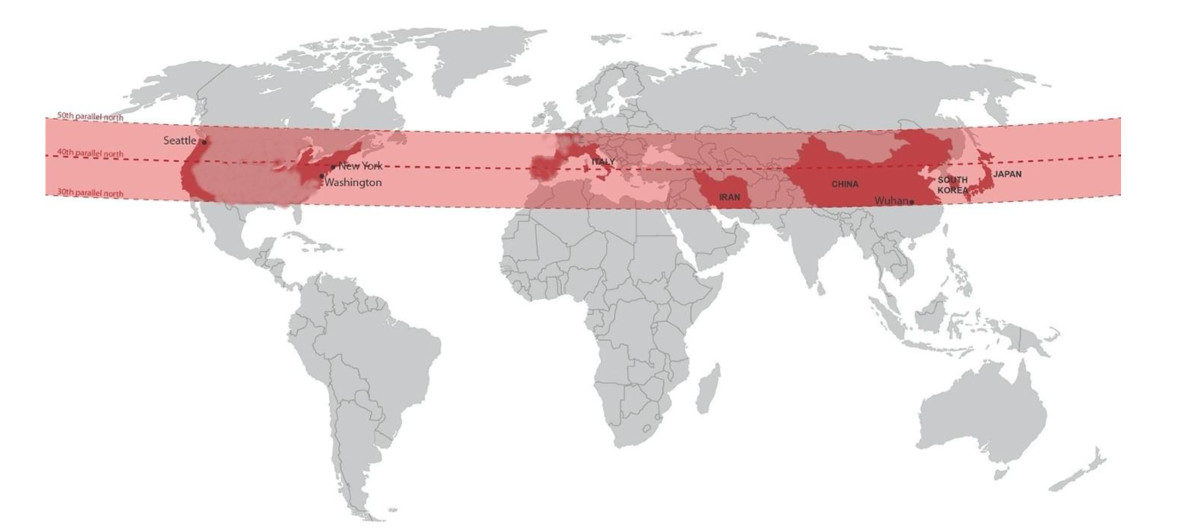
© EIN PressWireMap of Coronavirus spread.
Scientific researchers released their findings about the source and predicted direction of the coronavirus and proposed critical measures for the pandemic.
London, UK, — Professor Chandra Wickramasinghe and his team of researchers believe that the novel coronavirus
arrived on meteorites in Oct 2019 and instantaneously infected hundreds of thousands of people through the atmosphere, as meteorites were reported in China, Northern Italy, Michigan in October 2019. This is somewhat at odds with the mainstream assertion that it originated in bats in WUHAN, China. Given this disparity, they went to great lengths to produce a timely research paper to back up their argument.In the research paper released on COVID-19, Professor Wickramasinghe puts forward several thought-provoking arguments. Notably that: "our informed view is that many people were almost simultaneously infected and naturally inoculated with the same COVID-19 virus strain."

© EIN PressWireProfessor Chandra Wickramasinghe.
The research papers:
Predicting the future:
Predicting the Future Trajectory of COVID-19Origin:
Comments on the Origin and Spread of the 2019 CoronavirusSupport for their arguments can be found in scientific research recently published in Italy about the coronavirus being found in abundance in air filters which may indicate that it is an atmospheric phenomenon:
SARS-Cov-2 RNA Found on Particulate Matter of Bergamo in Northern Italy: First Preliminary EvidenceThe research also points out the obvious fact that the highest occurrences of
COVID-19 infections between December and April 2020, were all in the same belt of latitude. Perhaps the most remarkable feature of the foci of infection outside China is that they are all located close to latitude 30-50 degrees N.
Concerning the potential future direction of the virus and concerns by the WHO that regions such as Africa, Latin America and India may be particularly vulnerable in coming months, the research points out the likeliness that "a primary source of the virus from the troposphere declines in late spring due to well- attested atmospheric circulation patterns. A reservoir of viruses deposited in the troposphere will thus have a cyclical seasonal turn over - coming down more vigorously in the winter months. Likewise, a new virus deposited in the stratosphere over the northern temperate latitude belt will be largely confined to Northern latitudes until it diffuses to the southern hemisphere and is thereafter deposited to the ground 6 months later."
This is a relevant discussion particularly as it concerns the re-opening of several European countries and U.S. states who believe that they have flattened the curve in the end of April 2020. Professor Wickramasinghe says that: "We might predict that the in-fall in temperate latitudes may wane after April. However, if smaller clumps of viruses still remain in the stratosphere, the repeated flushing will occur seasonally over the winter months."
The scientists warn the various measures being taken to "contain" or "delay" the progress of this pandemic fall short of planning for resurgences caused by a continuing sequence of further in-fall episodes of this viral-dust.
What governments and their public health authorities don't realize is that there are two forms of exposure to the virus. The first, more intense and deadly, is the instantaneous infection through the exposure to the virus in the Earth's atmosphere and the second milder outbreak, comes subsequently from a person-to-person, community transmission.
This would explain how shelter-in-place measures outside the meteorite dust influx zones mitigated the community spread of the virus. However, zones where the virus was deposited into the atmosphere directly from the meteorite suffered as deadly hot spots.
Professor Wickramasinghe and his collaborators suggest that aircrafts, balloons and rockets could be deployed along with next generation gene sampling technologies to give us advanced warning of future pandemic-causing pathogens before they fall to Earth.
While Prof Wickramasinghe and his team unveil the mystery of the novel coronavirus and offer scientific evidence for the outbreak and its spread, it remains a mystery why public health authorities don't make it their priority to base their preventative measures on this remarkable astrobiology research and evidence."
About Professor Chandra Wickramasinghe: British astrobiologist, conducted doctoral research at University of Cambridge under the supervision of Sir Fred Hoyle, one of the most influential astronomers and cosmologists of the past 200 years. Wickramasinghe's influence is global. His nearly 300 published scientific papers (over 70 in the highest impact journal Nature) and 31 books are a veritable catalog of the evolution of the emerging science of astrobiology, and of his undisputed role in this area.
Adele Lamborn (Press Contact)
Prof Chandra Wickramasinghe
+1 415-935-0350
email us here
Is BG behind these studies?
Why are they ignoring all the evidence this thing was manufactured?
So are they saying sars1 came in this way too? HIV?